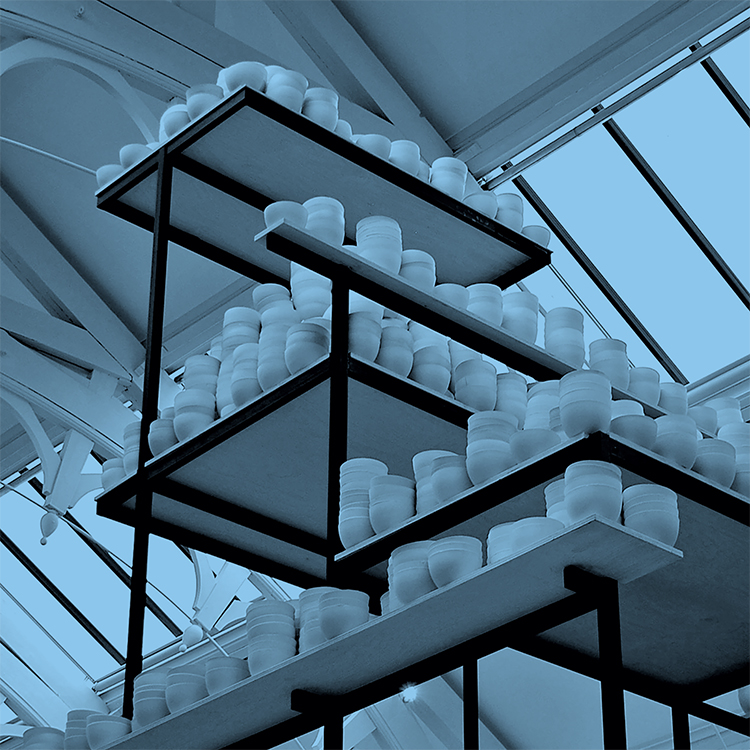As a part of her Royal College of Art graduate dissertation, Eva Masterman produced the first issue of C-Forum, her publication that seeks to flesh-out the cross-disciplinary state of clay in contemporary visual culture. It was shortlisted for the Henry Moore Fine Art Dissertation Prize this year. Alongside a shrewd new body of ceramic work that debuted during Ceramic Art London at the Royal College of Art, we give her an A+. We at CFile are also elated at the obvious shoutout in her title. She explains that C-Forum is a portmanteau of CFile and Art Forum. Extra Credit!
C-Forum is available to all of our readers as a limited-time free download— just click one of the blue buttons scattered through this post. Or view C-Forum in cfile.library.
Click to Download your FREE First Issue of C-Forum
Though primarily a venue to discuss ceramics, C-Forum addresses the whole art world rather than just a few artists or ceramists alone. The 43-page text is overflowing with articulations of the questions, frustrations, disappointments, and victories that makers of ceramics have felt collectively all over the world for some time. And its bedecked with photographs, not of her own work, but of ceramic artists who have found some success in the fine art world such as Aaron Angell of Troy Town Pottery and Jesse Wine. Masterman’s effort to outline what it takes to be accepted as a ceramist by the larger art world assures us that it takes more than just making the work and having the show. Masterman cites Grayson Perry, “…if a practitioner of any kind, including ceramicists, wants to move toward contemporary art they must embrace the language and the values of that discipline and direct their work toward the correct audience.” In other words, the contemporary art audience is not going to find you, you must find them! And seduce them!

Claire Twomey, Manifest: 10,000 Hours, 2015
Masterman puts some flesh on the bones of why exactly ceramic art has fallen so far behind other branches of the art world in being accepted as fine art. Of course we think we understand this to some degree, but Masterman notes that contemporary art has been defined for 100 years (since Duchamp’s 1917 Fountain and again made undeniably clear in the 60’s by Andy Warhol) as an idea, a concept that could find a possible representation in any material. The material itself becomes minor, and the idea superior. But this, in contrast to the emphasis that ceramic arts educators put on craftsmanship and mastery of a material, Masterman believes is the foundation of why ceramic art has been the toad of the fine art world–unable to keep up with other medium.

Jason Rhoades, Garage Renovation, New York, 1993
How do you invite the wider visual culture of fine arts to consider your work in their context when you find the ceramic art made by those non-specialist fine artists who are experimenting with clay rather repulsive? Start by attempting to understand what these newbies are making and where it’s coming from…
“Although the naïve ceramic work that is populating contemporary art fairs does not seem to have the same political agenda, the crash and subsequent recession of 2008 means that we are in a similar, some would say worse, situation than we were after the 1980s, especially where art and education are concerned. It is not a big leap to assume that the current surge in clay application in fine art might bear relation to that. There is less space to make and show art work, practically no government funding, art education is in turmoil, and in the case of ceramics, there is an epidemic of BA course closures. [Johanna] Drucker [who coined the term ‘Slacker Aesthetics’ in Sweet Dreams: Contemporary Art and Complicity] proposes that aesthetics in art reflect dominant issues in the world at large, so the return to more personal, hand made ‘sloppy craft’, especially in art ceramics, would be an apt reflection of the socio-economic disasters that regularly plague our news feeds.”
-Eva Masterman

Aaron Angell, Dei Marmory Show, 2014

Jesse Wine, Duravit 1, 2014
C-Forum is available to all of our readers as a limited-time free download. Or view C-Forum in cfile.library.


Add your valued opinion to this post.